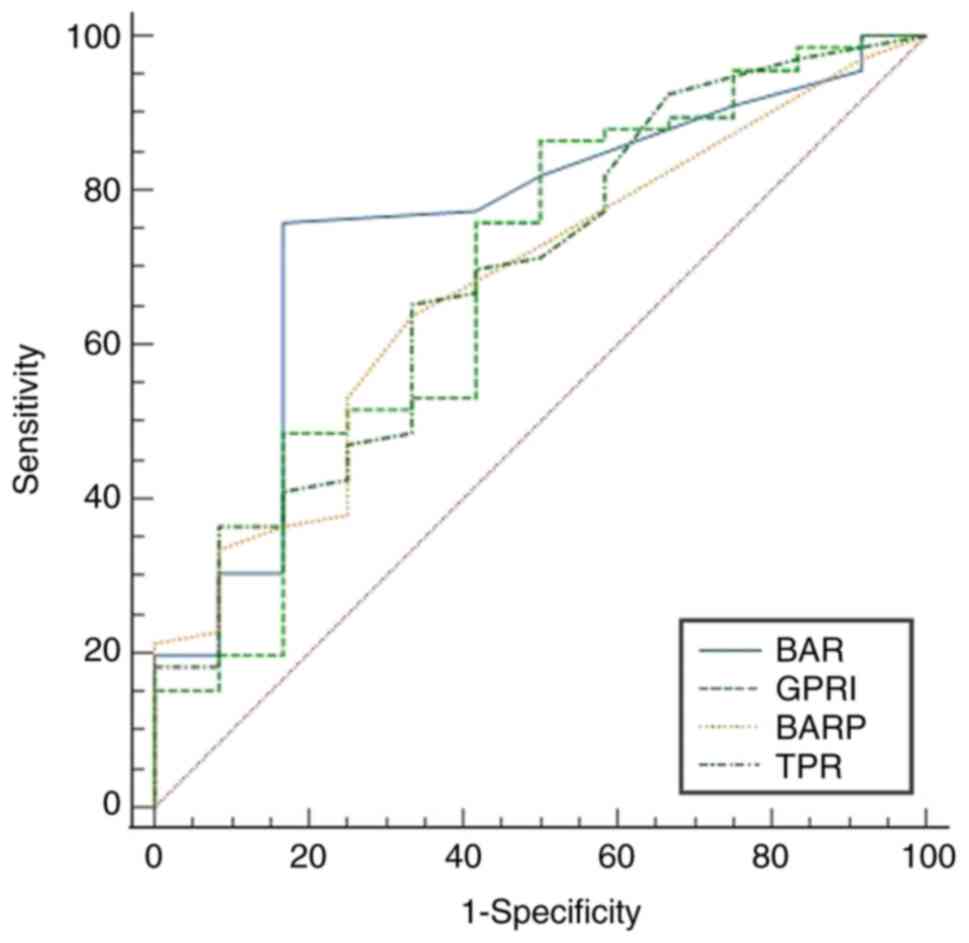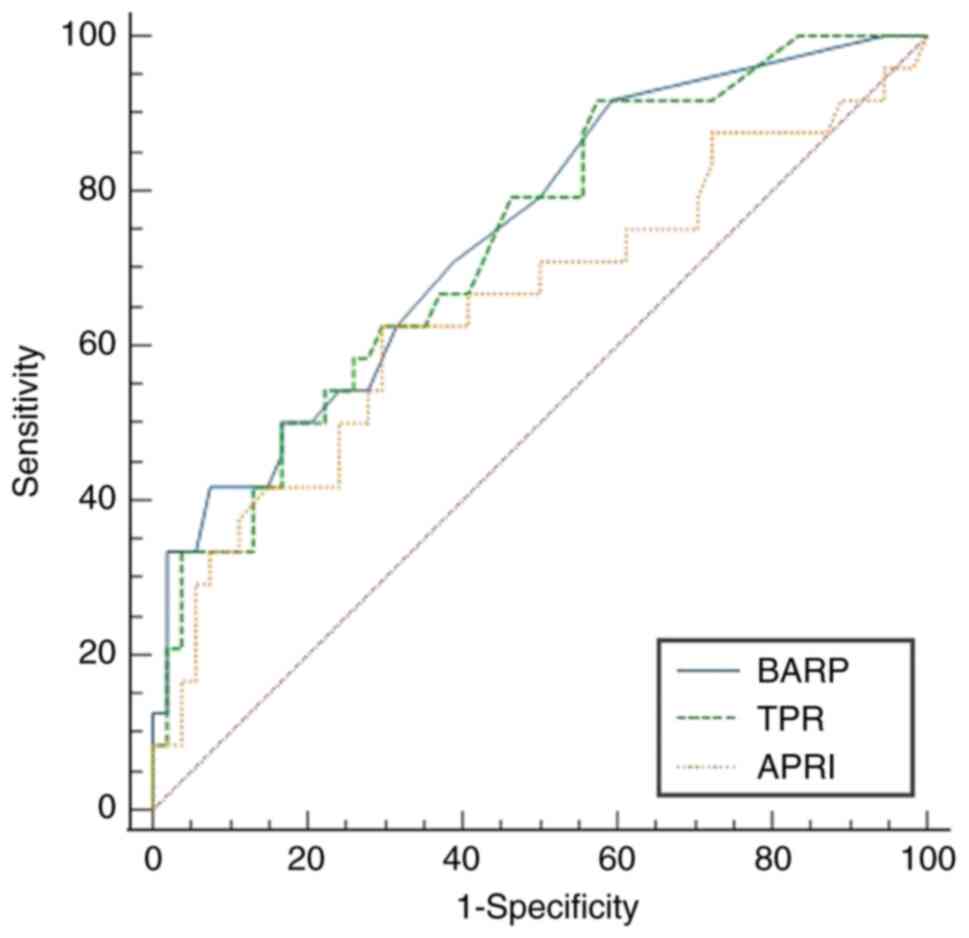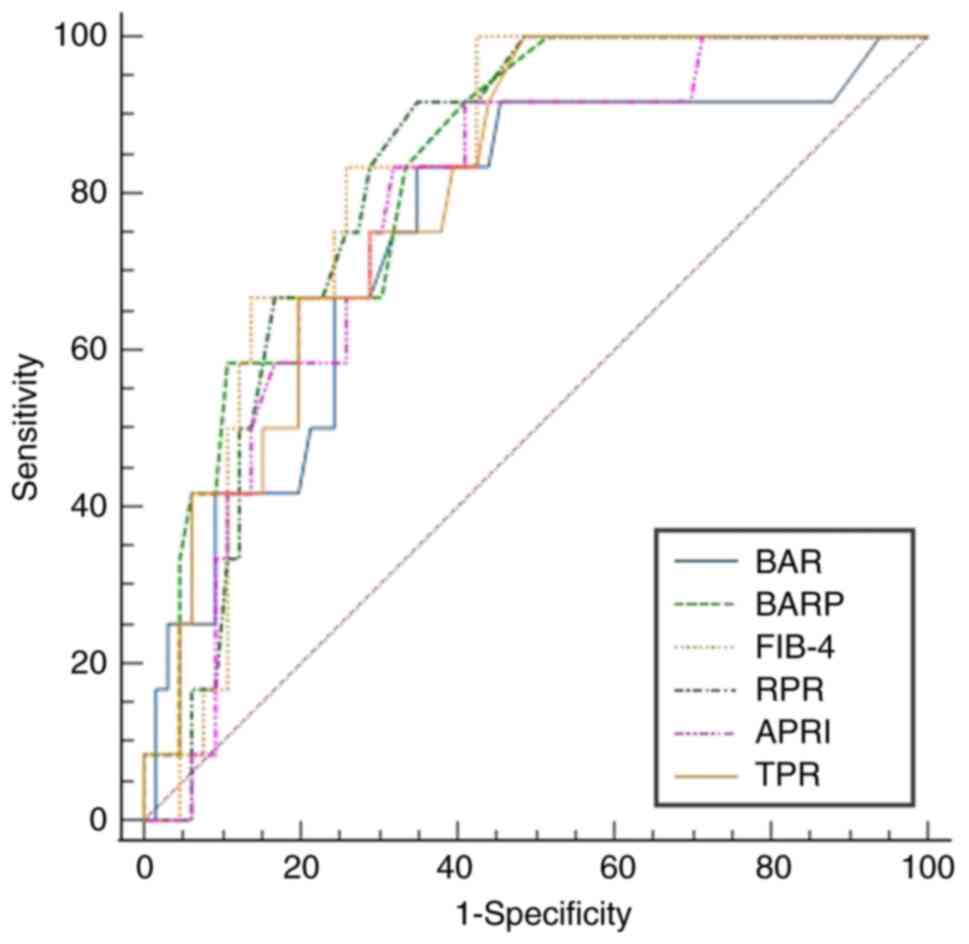|
1
|
You H, Duan W, Li S, Lv T, Chen S, Lu L,
Ma X, Han Y, Nan Y, Xu X, et al: Guidelines on the diagnosis and
management of primary biliary cholangitis (2021). J Clin Transl
Hepatol. 11:736–746. 2023.PubMed/NCBI View Article : Google Scholar
|
|
2
|
Xu XY, Ding HG, Li WG, Xu JH, Han Y, Jia
JD, Wei L, Duan ZP, Ling-Hu EQ and Zhuang H: Chinese guidelines on
the management of liver cirrhosis (abbreviated version). World J
Gastroenterol. 26:7088–7103. 2020.PubMed/NCBI View Article : Google Scholar
|
|
3
|
Cui XW, Li KN, Yi AJ, Wang B, Wei Q, Wu GG
and Dietrich CF: Ultrasound elastography. Endosc ultrasound.
11:252–274. 2022.PubMed/NCBI View Article : Google Scholar
|
|
4
|
Chang Y, Guo C, Guo G, Yuan Z, Zhou X,
Wang J, Han Z, Chen Y, Jia G and Han Y: Erythrocyte count is
associated with prognosis in Chinese patients with primary biliary
cholangitis. Exp Ther Med. 19:2075–2082. 2020.PubMed/NCBI View Article : Google Scholar
|
|
5
|
Tarantino G, Barrea L, Capone D, Citro V,
Mosca T and Savastano S: Hematocrit values predict carotid
intimal-media thickness in obese patients with non-alcoholic fatty
liver disease: A cross-sectional study. Front Endocrinol
(Lausanne). 9(203)2018.PubMed/NCBI View Article : Google Scholar
|
|
6
|
Sorokin A, Brown JL and Thompson PD:
Primary biliary cirrhosis, hyperlipidemia, and atherosclerotic
risk: A systematic review. Atherosclerosis. 194:293–299.
2007.PubMed/NCBI View Article : Google Scholar
|
|
7
|
Schulz M, Wilde ACB, Demir M, Müller T,
Tacke F and Wree A: Shear wave elastography and shear wave
dispersion imaging in primary biliary cholangitis-a pilot study.
Quant Imaging Med Surg. 12:1235–1242. 2022.PubMed/NCBI View Article : Google Scholar
|
|
8
|
Cristoferi L, Calvaruso V, Overi D, Viganò
M, Rigamonti C, Degasperi E, Cardinale V, Labanca S, Zucchini N,
Fichera A, et al: Accuracy of transient elastography in assessing
fibrosis at diagnosis in naïve patients with primary biliary
cholangitis: A dual cut-off approach. Hepatology. 74:1496–1508.
2021.PubMed/NCBI View Article : Google Scholar
|
|
9
|
Meng Y, Liang Y and Liu M: The value of
MRI in the diagnosis of primary biliary cirrhosis and assessment of
liver fibrosis. PLoS One. 10(e0120110)2015.PubMed/NCBI View Article : Google Scholar
|
|
10
|
Wai CT, Greenson JK, Fontana RJ,
Kalbfleisch JD, Marrero JA, Conjeevaram HS and Lok ASF: A simple
noninvasive index can predict both significant fibrosis and
cirrhosis in patients with chronic hepatitis C. Hepatology.
38:518–526. 2003.PubMed/NCBI View Article : Google Scholar
|
|
11
|
Reinson T, Buchanan RM and Byrne CD:
Noninvasive serum biomarkers for liver fibrosis in NAFLD: current
and future. Clin Mol Hepatol. 29 (Suppl):S157–S170. 2023.PubMed/NCBI View Article : Google Scholar
|
|
12
|
Wang Z, Zhou Y, Yu P, Liu Y, Mei M, Bian
Z, Shao W, Lv J, Li X, Lu W and Xu L: Retrospective evaluation of
non-invasive assessment based on routine laboratory markers for
assessing advanced liver fibrosis in chronic hepatitis B patients.
Int J Gen Med. 15:5159–5171. 2022.PubMed/NCBI View Article : Google Scholar
|
|
13
|
Nakano T, Inoue K, Hirohara J, Arita S,
Higuchi K, Omata M and Toda G: Long-term prognosis of primary
biliary cirrhosis (PBC) in Japan and analysis of the factors of
stage progression in asymptomatic PBC (a-PBC). Hepatol Res.
22:250–260. 2002.PubMed/NCBI View Article : Google Scholar
|
|
14
|
Vardar G, Okan MA, Karadag N, Topcuoglu S,
Ozalkaya E, Karatepe HO and Karatekin G: Intravenous immunoglobulin
in hemolytic disease of the newborn: A moving target in time. Niger
J Clin Pract. 25:1262–1268. 2022.PubMed/NCBI View Article : Google Scholar
|
|
15
|
Li Y, Liu H, Chen K, Wu X, Wu J, Yang Z,
Yao L, Wen G, Zhang C, Chen X, et al: Pathological significance and
prognostic roles of indirect bilirubin/albumin ratio in hepatic
encephalopathy. Front Med (Lausanne). 8(706407)2021.PubMed/NCBI View Article : Google Scholar
|
|
16
|
Wang L, Sun K, Tian A, Liu Y, Zhang M,
Zhou X and Han Y: Fenofibrate improves GLOBE and UK-PBC scores and
histological features in primary biliary cholangitis. Minerva Med.
113:974–982. 2022.PubMed/NCBI View Article : Google Scholar
|
|
17
|
Warnes TW, Roberts SA, Smith A, Cope VM,
Vales P, Haboubi NY and McMahon RF: Portal hypertension in primary
biliary cholangitis: Prevalence, natural history and histological
correlates. Eur J Gastroenterol Hepatol. 33:1595–1602.
2021.PubMed/NCBI View Article : Google Scholar
|
|
18
|
Hirschfield GM, Dyson JK, Alexander GJM,
Chapman MH, Collier J, Hübscher S, Patanwala I, Pereira SP, Thain
C, Thorburn D, et al: The British society of
gastroenterology/UK-PBC primary biliary cholangitis treatment and
management guidelines. Gut. 67:1568–1594. 2018.PubMed/NCBI View Article : Google Scholar
|
|
19
|
Gherlan GS: Liver ultrasound elastography:
More than staging the disease. World J Hepatol. 7:1595–1600.
2015.PubMed/NCBI View Article : Google Scholar
|
|
20
|
Yu JH, Lee HA and Kim SU: Noninvasive
imaging biomarkers for liver fibrosis in nonalcoholic fatty liver
disease: Current and future. Clin Mol Hepatol. 29 (Suppl
1):S136–S149. 2023.PubMed/NCBI View Article : Google Scholar
|
|
21
|
Branchi F, Conti CB, Baccarin A,
Lampertico P, Conte D and Fraquelli M: Non-invasive assessment of
liver fibrosis in chronic hepatitis B. World J Gastroenterol.
20:14568–14580. 2014.PubMed/NCBI View Article : Google Scholar
|
|
22
|
Florea M, Serban T, Tirpe GR, Tirpe A and
Lupsor-Platon M: Noninvasive assessment of hepatitis C virus
infected patients using vibration-controlled transient
elastography. J Clin Med. 10(2575)2021.PubMed/NCBI View Article : Google Scholar
|
|
23
|
Castera L, Friedrich-Rust M and Loomba R:
Noninvasive assessment of liver disease in patients with
nonalcoholic fatty liver disease. Gastroenterology.
156:1264–1281.e4. 2019.PubMed/NCBI View Article : Google Scholar
|
|
24
|
Michalak A, Guz M, Kozicka J, Cybulski M,
Jeleniewicz W, Lach T and Cichoż-Lach H: Red blood cell
distribution width derivatives in alcohol-related liver cirrhosis
and metabolic-associated fatty liver disease. World J
Gastroenterol. 28:5636–5647. 2022.PubMed/NCBI View Article : Google Scholar
|
|
25
|
Jiang M, Yan X, Song X, Yan Q, Zhao Y,
Wang L and Gao P: Total bile acid to platelet ratio: A noninvasive
index for predicting liver fibrosis in primary biliary cholangitis.
Medicine (Baltimore). 99(e20502)2020.PubMed/NCBI View Article : Google Scholar
|
|
26
|
Jiang X, Wang Y, Su Z, Yang F, Lv H, Lin L
and Sun C: Red blood cell distribution width to platelet ratio
levels in assessment of histologic severity in patients with
primary biliary cholangitis. Scand J Clin Lab Invest. 78:258–263.
2018.PubMed/NCBI View Article : Google Scholar
|
|
27
|
Wang H, Xu H, Wang X, Wu R, Gao X, Jin Q
and Niu J: Red blood cell distribution width to platelet ratio is
related to histologic severity of primary biliary cirrhosis.
Medicine (Baltimore). 95(e3114)2016.PubMed/NCBI View Article : Google Scholar
|
|
28
|
Meng J, Xu H, Liu X, Wu R and Niu J:
Increased red cell width distribution to lymphocyte ratio is a
predictor of histologic severity in primary biliary cholangitis.
Medicine (Baltimore). 97(e13431)2018.PubMed/NCBI View Article : Google Scholar
|
|
29
|
Avcioğlu U, Eruzun H and Ustaoğlu M: The
gamma-glutamyl transferase to platelet ratio for noninvasive
evaluation of liver fibrosis in patients with primary biliary
cholangitis. Medicine (Baltimore). 101(e30626)2022.PubMed/NCBI View Article : Google Scholar
|
|
30
|
Tahtaci M, Yurekli OT, Bolat AD, Balci S,
Akin FE, Buyukasik NS and Ersoy O: Increased mean platelet volume
is related to histologic severity of primary biliary cirrhosis. Eur
J Gastroenterol Hepatol. 27:1382–1385. 2015.PubMed/NCBI View Article : Google Scholar
|
|
31
|
Hayashi M, Abe K, Fujita M, Takahashi A,
Hashimoto Y and Ohira H: Serum Gas6 and Axl as non-invasive
biomarkers of advanced histological stage in primary biliary
cholangitis. Hepatol Res. 50:1337–1346. 2020.PubMed/NCBI View Article : Google Scholar
|

















